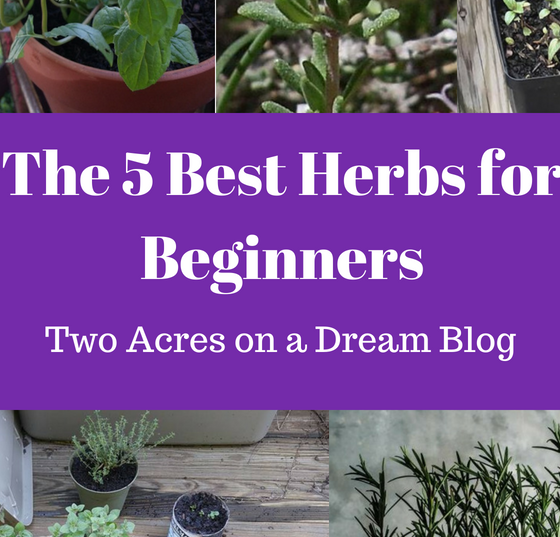
The best herbs for beginners are the ones you will use! Seriously, no matter what I write here, or what you read elsewhere, if you see an herb on a list and you know you don’t like it, DON’T GROW IT. It will just languish in your garden wondering why you don’t love it. Yes, my plants have personalities. No, I don’t talk to them….. Loudly.
I was supposed to write this blog post the week I wrote about Herbs for Fibromyalgia, Herbs for Mom, but I really felt moved and impassioned to get that blog out there. Maybe there was someone who really needed to see it. In any case, I wrote that one, and here we are with the best herbs for beginners! The big thing is that I think this post can still be useful since a lot of people (in the US at least) haven’t planted their seedlings yet!
Aside from personal preference, these are the herbs I would recommend for the beginning herb gardener because I find them useful and forgiving. You know, I started this whole journey with three hanging pots with two different types of herbs each. Yes, I ended up on two acres in Maryland, with chickens and planning for goats, lambs, and ducks because of three small hanging pots I planted in Georgia. Makes you wonder if my husband would go back and throw those pots in the neighbor’s yard, doesn’t it?
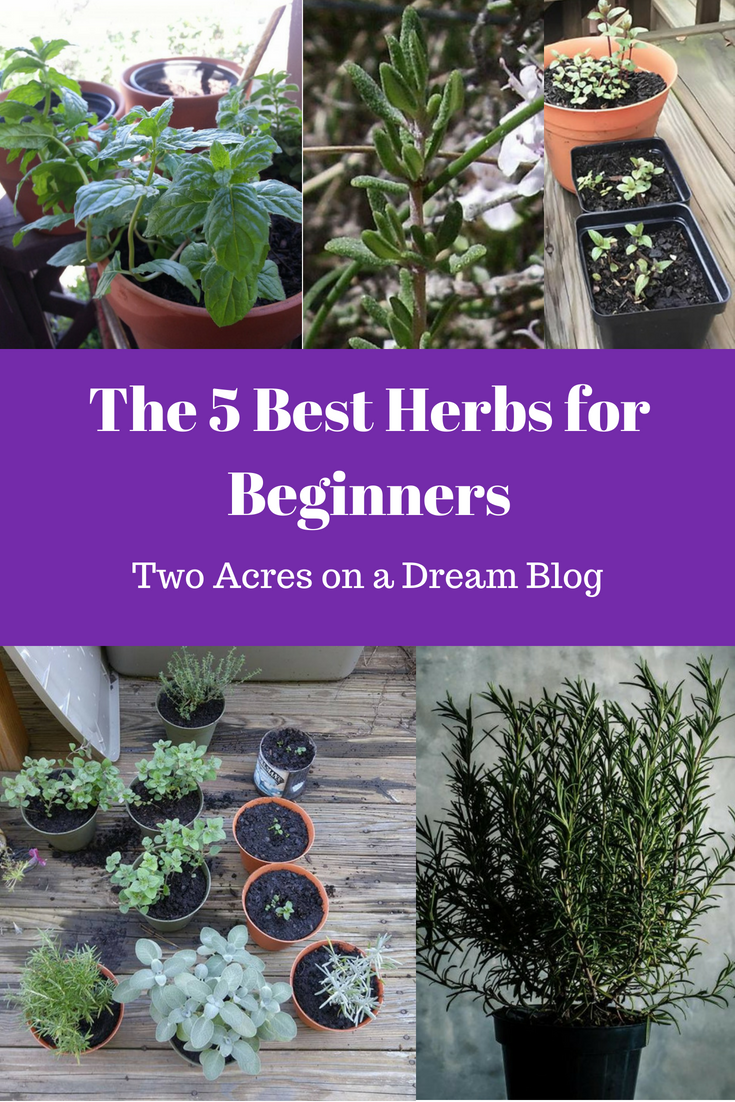
The Five Best Herbs for Beginners…. in my opinion anyway!
Top Five Herbs for Beginners
Oregano
Oregano, how I love thee. Let me count the ways. This small herb will become one of the most prolific in your garden. Yes, I know it looks small and shrimpy while you’re looking at it in the nursery, but I purchased one oregano plant in the spring and divided into three plants that fall. The following spring, I took the two plants I had left (gave one away), and divided those in half, giving me four oregano plants. Do you see where this is going?

I went from one small oregano plant to five plants in one year!
Growing and Caring for Oregano
I wouldn’t recommend planting this herb in the ground, although I know a lot of people do. I don’t know if oregano particularly loves me, but it’s in the mint family. With the way it grows for me, I can’t ever forget it.
I let the soil for all of my herbs dry out a bit, but if you find you have ever left your oregano too dry (i.e. it looks like its dead), water it anyway and wait about an hour or two. Mine has always bounced back! When I harvest, I take a stem and cut it all the way back to the base. This encourages bushy growth instead of super tall leggy growth.
Culinary and Medicinal Uses of Oregano
I love taking oregano stems, stripping them with my fingers, and tossing them into food for a lovely pop of green. I do this with red pasta sauces, but also with scrambled eggs and stews! There are a lot of different varieties of oregano out there; I normally purchase greek oregano myself.
Medicinally, oregano possesses anti-bacterial properties, and it great to toss into most of your cold tea or syrup blends. I love oregano in my “everyone-around-me-is-sick” tea blend because I feel like I’m drinking a forest 🙂
Mint
After talking about oregano, I have to admit that mint isn’t one I love QUITE as much, but it still gets a lot of use in my home. Mint is a great herb for beginners! Just like my oregano, I bought small shrimpy versions of the mint varieties I wanted (yes, you read that right, varitIES), and I ended up with more than I knew what to do with. Not really, since I will dry and freeze my herbs like no one’s business. I know what to do with them, and wasting them isn’t on the list!
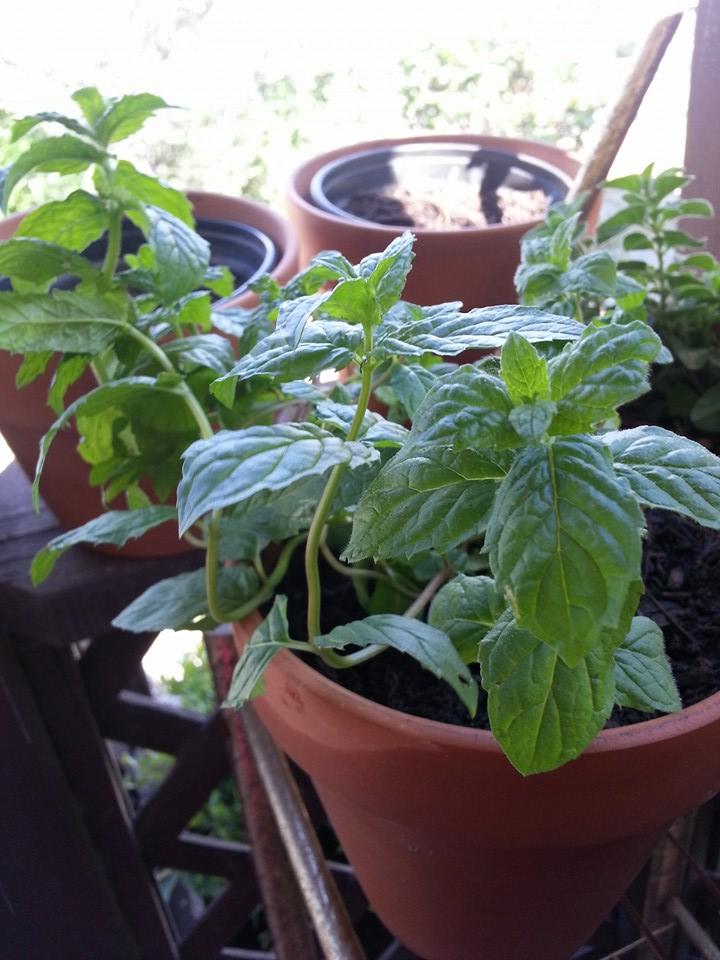
My lovely potted spearmint
Growing and Caring for Mint
Mint loves water, it really does. That doesn’t mean you should keep it wet constantly though. I can’t think of many herbs that like to be constantly wet. This encourages fungal growth, which encourages dead plants. I also take the stems from this plant and cut them down to the base. Mint plants grow runners underneath the soil that will go to the edge of the pot, which is why you should NEVER plant it in the ground. It will take over whatever garden bed you put it in, and then manage to get out into your other beds. DON’T DO IT.
There are a lot of mint varieties out there, and I encourage you to buy any that suit your fancy. You need to place the pots at least 1 foot apart though, or the mint types will intermingle. Then you’ll be left with mint plants that might not be that minty. I’ve grown spearmint, mojito, apple (wholly variety), and chocolate mint types. They’re all great!
Culinary and Medicinal Uses of Mint
Mint ends up in my infused water with chopped up fruits or veggies all summer and into early fall. My kids call it “special water”, and they love to drink it. They’ll ask for it over any sort of juice, which is always nice. Obviously, mint can end up in your mojitos too, and people love to put a sprig in sherbet.
Peppermint and mint don’t have the same medicinal properties. Actually, peppermint is considered more medicinal than mint because it contains more menthol. Foodiegardener.com says that “people have “mint confusion” and lump the two together, but there are some marked differences.” Menthol has a sweeter taste, while peppermint seems stronger to most people because of that additional menthol. I put mint in my medicinal tea blends and syrups to help sweeten the flavor.
Rosemary
I’ve always had a rosemary plant. Rosemary was one of my Original Six. Sadly though, that means I’ve always had to leave rosemary behind because of military moves. It gets pretty large given enough time. Now that we own our home though, I’m looking forward to planting a couple of rosemary babies in my herb garden. Eventually, I’d like to plant a couple near one of our entryways. Rosemary smells wonderful, and I think it would be a nice way to usher guests into the house!
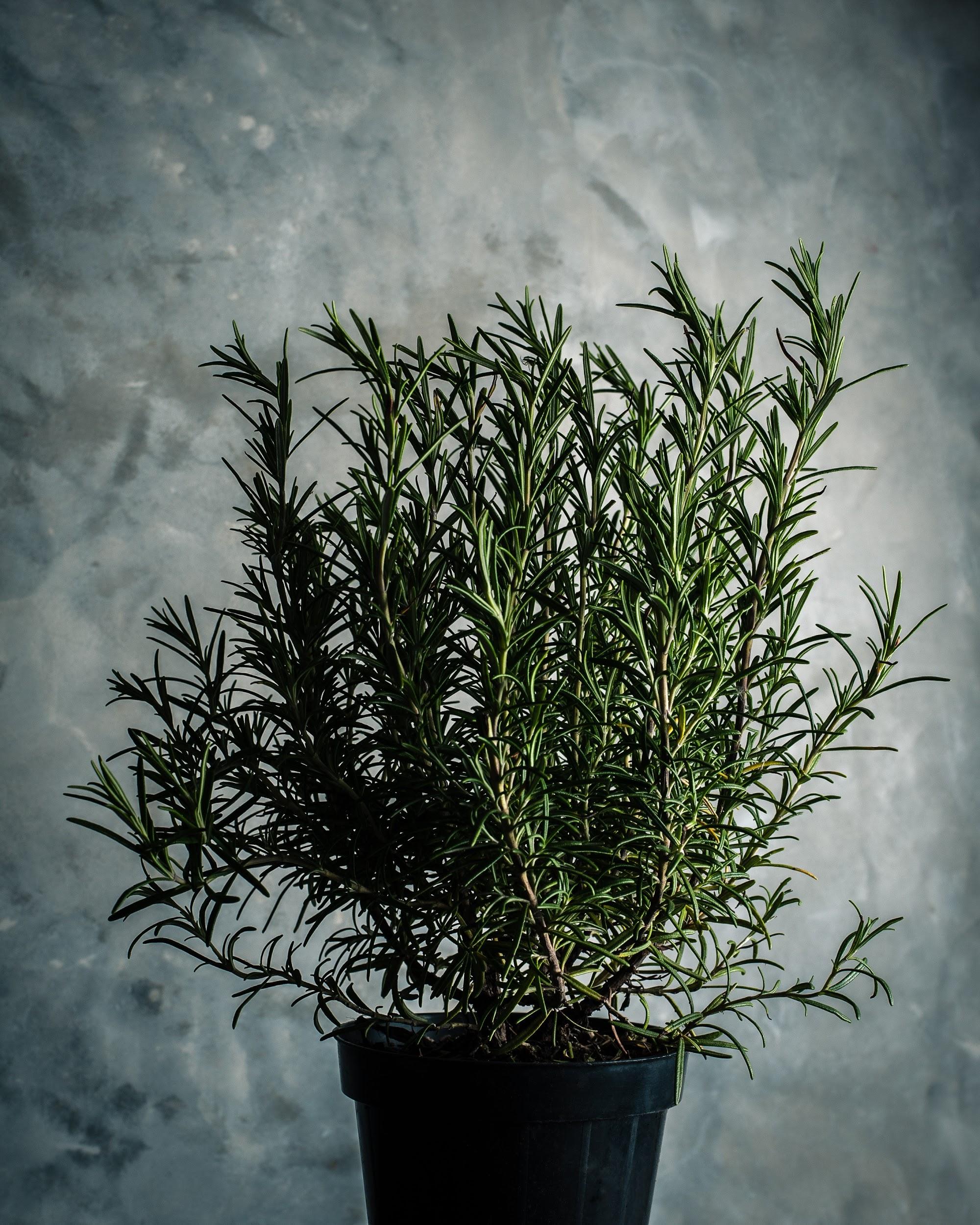
Rosemary is sold as a tiny plant, but watch out! It will get big!
Caring and Growing for Rosemary
Rosemary is a Mediterranean shrub, and it likes well-drained soil. Through regular harvesting and trimming, you can keep it from getting to shrub size though. I keep an eye on how tall my rosemary tries to get and harvest the longest stems first to redirect some energy back into the base of the plant. When you do harvest it, you want to look for the tender new growth which will be more towards the ends of each stem. That is where the best oils are.
Culinary and Medicinal Uses of Rosemary
Rosemary and beef, you just can’t separate the two in my house. We prefer fresh rosemary over dried rosemary. My beef stews always have a healthy amount of rosemary in them. I know people make rosemary chicken too, but it has just never sounded as tasty to me. So I pair it with beef and lamb dishes most often.
Rosemary is known to have antifungal, antibacterial, antiseptic, and anti-inflammatory properties. Rosemary can also help with memory and alertness. I know more than one person who keeps a spray bottle with rosemary oil and water in it to spritz at their desk in the afternoon.
Thyme
I started with a creeping thyme plant. I believe it was Elfin Thyme. That one had slow growth for me and was harder to harvest than the types I purchased later (my latest was French Thyme). I would recommend the more shrub-like thyme over the creeping thyme to make your harvest easier. Thyme is still an herb I’m getting to know, so I haven’t discovered any quirks in its personality yet. If you have some, put it in the comments!
Growing and Caring for Thyme
The Mediterranean lays claim to thyme, just like rosemary. However, you’ll find it in so many herb gardens…. Well everywhere. It is sold in almost every plant nursery. Because of its Mediterranean origins, you can assume that it loves well-drained soil, and you would be correct! Clay dominates my soil, so before planting it in the ground this year, I will amend the area with my homemade compost and perhaps some organic gardening soil. Great idea for the rosemary plants too actually….
Thyme is another herb that is shrubby, so when you harvest it, cut to just above the green portions of the stem. That is where the new growth is. Sometimes it does need management though, so before it gets cold, you may want to cut into the woody portions to cut it back some.
Culinary and Medicinal Uses of Thyme
Now I use thyme with I’m cooking lighter meats like chicken or some types of fish. It has a more delicate flavor, so I find that it balances well with meat that isn’t as strong as beef. Again my personal preference, but if you have a beef and thyme recipe you think I have to try, you know where to put it (psst: put it in the comments!).
I put thyme in my “everyone around me is sick” tea blend as well. My kids have also had thyme and oregano syrup for coughs. Thyme works miracles on coughs and sore throats, you just need to catch it as early as you can. This is true when you use any herb to treat or manage an illness. You need to catch it as early as you can to be the most effective.
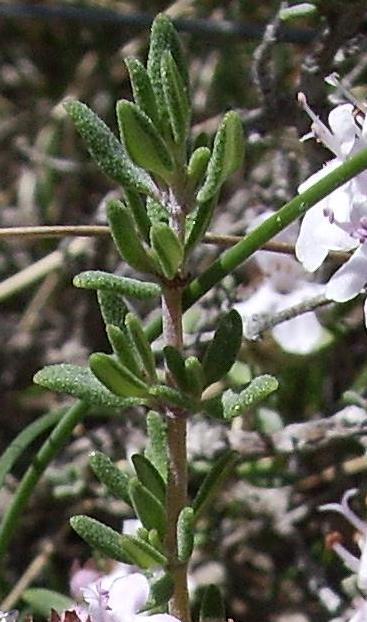
A stem of wild common thyme
Sage
Sage has been a tough one for me. I got my first herbs when I was pregnant with my first son. Breastfeeding women have to avoid sage because of its great drying properties, meaning it will decrease their supply! In the last four years, I’ve had three children (well the third will be born in April), so I have spent a lot of time breastfeeding. I still use it smudge or cleanse the air before praying, or in medicinal remedies for the kids.
Growing and Caring for Sage
Sage is another Mediterranean herb, and you can pick multiple varieties! Each year I have stuck with garden sage. It seems to do a great job growing bushy on its own. I have always just harvested the leaves as I needed them, taking care not to take too much from anyone stem. It has a soft and fuzzy appearance but has been very cold resistant for me.
Culinary and Medicinal Uses of Sage
You can put sage in stuffing, which many people do around the holidays, but that isn’t all its good for. When I have been able, a couple of leaves in a fresh bread mix really gives off a great aroma. You can also add sage leaves into your basil pesto for a different flavor.
You can use sage whenever runny noses run amok in your house. As I mentioned before, women use it to help dry up breastmilk supply and wean their children. I had great success one year with a thyme, sage, and mint syrup I created for the kids when they all had coughs and runny noses. As soon as I saw the hint of a runny nose and heard that first cough, everyone got a dose every few hours!
Most of my medicinal knowledge comes from a book by Rosemary Gladstar called Rosemary Gladstar’s Medicinal Herbs: A Beginner’s Guide [<—affiliate link!!!], and the Internet of course. I recommend the book all of the time to people dipping their toes into medicinal herbalism. It isn’t expensive, has great pictures, wonderful explanations, and easy herbal remedies/recipes for you to start out with. She has written other books as well, which I need to add to my personal library for sure!
Alright, hit me with it. There are my top recommendations, but I know that you’re thinking “But Ruthie you forgot ____!” If you have an herb that you just need to express your love for, get in the comments! I want to hear about why you love it, quirks you know of, and if you have any favorite herbal remedies that use it!

Leave a Reply